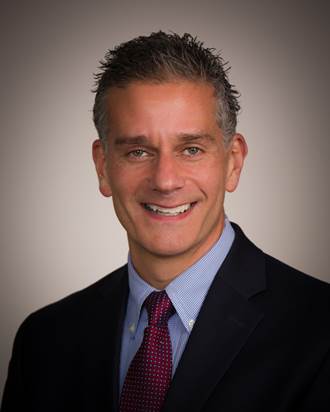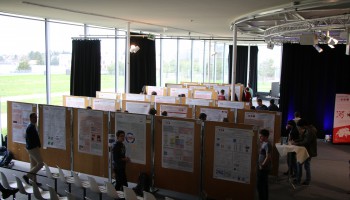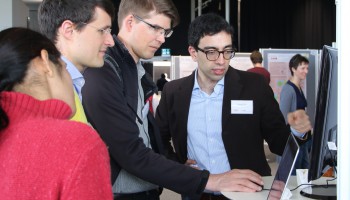What MARVEL is doing is a dream come true for researchers in the field
by Carey Sargent, EPFL, NCCR MARVEL

Professor Scott Auerbach (University of Massachusetts, Amherst, USA)
Photo credit: HadarGoren-HHMI
Let’s start at the beginning. How did you wind up at MARVEL?
I helped develop a program at UMass called iCons that is all about real world learning in the fields of energy and biomedicine. When we launched it in 2010, we got a piece in a magazine called Chemical & Engineering News — it's sort of the People magazine of the field of chemistry. That was a great coup because in one fell swoop 160'000 people were aware of the iCons Program, including Tom Rizzo, the then-dean of the Faculty of Basic Sciences at EPFL.
He was very interested in this real-world learning and so he came to Amherst to learn about iCons; that was my first real connection to EPFL. When he gave his talk about EPFL and what its goals were, he started with the classic picture of the EPFL campus, with Lake Geneva and the mountains... at that point I knew I would be going to that place someday. I stayed in touch with Tom and he put me in touch with Nicola Marzari and, as they say, there was good chemistry and the rest is history.
What are you doing here?
We have come a long way in our research on zeolites, creating models and simulations that actually show movies of how they form. If all we learn is "oh it built a structure" then we're missing the full picture. Before the final structure there may be some interesting information there. There's a question — is there some intermediate or local pattern that gets formed that could presage a structure?
They say that chaos is in the eye of the beholder. Before the simulation forms an ordered zeolite structure, there's some disorder, but maybe it's not totally chaotic. For example, we have this fixation with the concept of "rings" in zeolite science. Suppose a final structure has a lot of three rings. Is it possible that just before this structure is made there are a lot of three rings in the amorphous blob and that those three rings eventually make it into the final structure? So there's a concept of pattern recognition. I’m not an expert on that, but Michele Ceriotti is an expert on general pattern recognition, and Berend Smit has tons of experience modeling zeolites, so in understanding how zeolites form, there’s some special expertise here in MARVEL in using machine learning and simulations to recognize patterns that we otherwise wouldn’t be able to see by eye.
At the MARVEL site visit I was amazed by the range of different materials. [...] there's an incredible spectrum, a portfolio of important materials under study.


MARVEL site visit, 10 Apr 2018. Left: poster session. Right: AiiDA and Materials Cloud booths Photo credit: Nathalie Jongen, MARVEL
What are your impressions of the work you see being done here at MARVEL in general?
At the MARVEL site visit I was amazed by the range of different materials. Whether it's complex transition metal oxides like the perovskites, which are very likely to be a game changer in solar energy if we can figure out how to make them stable to water, or lithium batteries, which have the potential to be a game changer in storing energy from solar and wind, if we can only figure out how to increase the energy density, to metal organic frameworks that have an ability for modular design and have potential for storing CO2 which is something we need to figure out how to do... there's an incredible spectrum, a portfolio of important materials under study.
I’d seen bits and pieces of AiiDA and Materials Cloud over the last several weeks here, but when I saw the talks given at the MARVEL site visit and saw that it was a cross-cutting thing—every single speaker talked about how their field and their calculations both contribute to AiiDA and Materials Cloud but also benefit from them—it was like the scales fell from my eyes.
What do you think about AiiDA and Materials Cloud?
What makes AiiDA so special... special is always in a context. For me the context is this: for every U.S. National Science Foundation proposal I need to include a data management plan. I didn't really understand what "data management plan" meant until I came here and I saw what AiiDA was, which is a platform that allows people to collaborate by understanding the workflows that they've gone through.
Materials Cloud is special in that in a sense it allows people to bring their research findings to life. So often what we do is publish a picture of a structure or a graph. If you as a reader want to do something with that, you can't. You can print it off or do a screenshot, but if you want to actually manipulate it or make a change to it, to take it one step further... it's the essence of what science is. Newton said, "if I can see farther than others it's because I have stood on the shoulders of giants." What standing on the shoulders of giants means is being able to take what other people have done and make changes, manipulate a structure — that's one of the exciting things that Materials Cloud lets you do. But just being able to do that isn't enough. You need to understand the workflow that led to that structure. AiiDA allows you to understand and add to a work flow to push science forward.
I’d seen bits and pieces of AiiDA and Materials Cloud over the last several weeks here, but when I saw the talks given at the MARVEL site visit and saw that it was a cross-cutting thing — every single speaker talked about how their field and their calculations both contribute to AiiDA and Materials Cloud but also benefit from them — it was like the scales fell from my eyes. I felt like my concept of a "data management plan" had been totally trivial. I feel like what MARVEL is doing... it's a dream come true for researchers in the field of computational materials. We know that we need this, but no one has really had the vision or expertise to put it together until now.
And it's not just about doing research — it's also about the credibility of research. You see, there's an epidemic of unreproducible research. I mean the field of psychology probably gets the worst rap for that. The field of materials science gets a rap as well, with certain materials reported that are difficult to reproduce in other labs. And even, to some extent, computational materials science has this credibility problem. Bottom line: when you can't reproduce somebody else's work, obviously it pulls the rug out from under the credibility of their work. The flip side is that when you make your work so open that anybody can see the workflow that you did and can see the result of your work, it lends additional credibility. And so that's another thing that I think is a very important by-product of AiiDA and Materials Cloud is that it makes it so clear that MARVEL is very confident about the rigor of their work. They're basically saying "here's the laundry" — it's not dirty, but it's laundry and I think that lends amazing credibility.
Click here to read more about Auerbach's research.
Click here to read more about the iCons program.
Low-volume newsletters, targeted to the scientific and industrial communities.
Subscribe to our newsletter